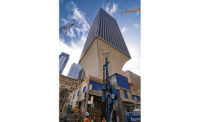 |
Demolition of a damaged 1,000-ft-tall television tower brought down a neighboring tower despite the contractor’s best efforts. But the second tower’s collapse revealed a defect that the owner had not suspected. An investigation could lead to legal action against the antenna’s manufacturer and inspections and remedial work throughout the country, the owner says.
 |
| Near Miss. Charges couldn't be properly placed on high guys. |
Four Army aviators died and one was injured when their MH-47 Chinook helicopter struck the tower in rural Colquitt County, Ga., about 8 a.m., Thursday, June 1. “The helicopter broke into three pieces,” says David Folsom, vice president of Raycom Media Inc., Montgomery, Ala., owner of the towers. The front rotor and cockpit fell at the base of the tower, killing the pilot and three other crew members. But the copilot, suffering a broken arm and a head injury, climbed out of the wreckage and walked to a house nearby, says Folsom. One of its occupants, an emergency-room nurse, tended to his injuries and then discovered the dead crewmen.
The front rotor of the dual-rotor aircraft severed one guy wire and struck the tower at the 925-ft level. “We had no idea what the structural damage to the tower was,” says Folsom. But the pull of the other two guys at the ninth level began causing the tip of the tower to creep.
Inspections by two structural engineers produced a model June 2 showing that the tower, made by PiRod Inc., Plymouth, Ind., could withstand slight winds up to about 30 knots. “They thought it could collapse at any moment because of the [8,000-lb] weight of the antenna,” says Folsom.
On June 2, Folsom called Controlled Demolition Inc., Phoenix, Md., to consult on blowing off the antenna, but “by Saturday or Sunday, it was hopeless,” he says. “We had already been through one thunderstorm,” and feared that the tower would fall on its own, he adds.
The structural consultants advised that detensioning the remaining two guys at the top could start harmonic rotation leading to rapid failure. Further complicating the problem, another 1,000-ft-tall tower stood 118 ft away. In plan view, the southeast guy axis of that tower, made by Radian Corp., Oakville, Ontario, interlaced with the PiRod’s northeast guy axis. CDI President Mark Loizeaux told Folsom he was prepared to bring down the PiRod tower alone by severing all the guys on its northeast axis with shaped charges, allowing the guys on the other two axes to pull it away from the neighboring tower. But he offered only a 30% chance of success. “[Folsom] said to just bring the tower down. If the other comes down, it comes down,” says Loizeaux.
The charges had to be placed so that the severed guys would not strike the other tower’s as they fell. “We managed to create a jig that permitted us to slide shaped charges up the guys of the PiRod tower,” says Loizeaux. A 4-wheel-drive all-terrain vehicle pulled the jig, consisting of a section of plastic pipe, to the selected point on each guy. But on the top two levels, the angle was too steep. The charges could not go higher.
It almost worked. “The PiRod tower moved perfectly until the upper two guys swung down and basket-wrapped the guy on the Radian tower,” says Loizeaux. The intertwined guys pulled down the undamaged tower.
As the Radian tower fell, Folsom and Loizeaux saw the antenna break up. On the ground, they found the steel separated at the weld. All that had held the antenna together was the fiberglass covering. “There’s not a doubt in my mind, not even a small amount,” that it was about to fail in any event, says Folsom.
If forensic engineers find the antenna defective, Folsom says he expects a lawsuit because it’s the second failure Raycom has experienced on an antenna by this manufacturer, which he would not name. Raycom owns 53 TV stations. Folsom anticipates nationwide inspections of the company’s antennas.
(Photos courtesy of Controlled Demolition Inc.)


Post a comment to this article
Report Abusive Comment